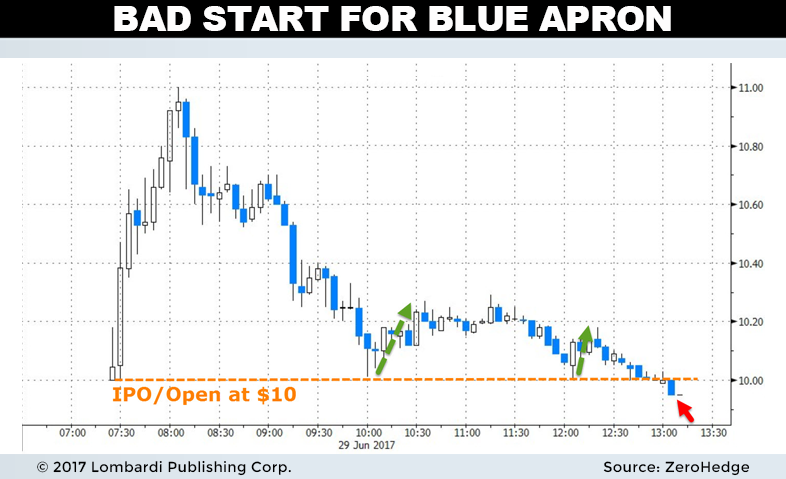An Early Indicator of Stock Market Crisis Is Failing New Issues; It Just Happened on NASDAQ
One important way to gauge the health of an exchange is through the interest generated by its anticipated new issues. If the sagging interest in Blue Apron Holdings Inc (NYSE:APRN) is any indication, a stock market crisis may not be far off.
After all, when the markets are strong, investors tend to scoop up anticipated new issues quickly. Initial offering prices often get traded at the high end of the Initial Public Offering (IPO) range, or re-priced higher altogether. The newly-minted company might offer additional shares to meet demand. Investors are always looking for a promising new stock to make them money.
This was supposed to be the case with Blue Apron. It was among the most anticipated IPOs to hit the market in 2017. In a market starved for companies producing rapid organic growth, Blue Apron had done just that. According to CEO Matthew Salzberg, the fresh ingredient and recipe delivery service has grown its business tenfold over the past two years, with strong “unit economics” in terms of amount of revenue generated per customer. Growth is certainly not in question. (Source: “Blue Apron shares are basically flat in their first day of trading,” CNBC, June 29, 2017.)
Also Read:
Stock Market Crash 2017? This Could Trigger a Stock Market Collapse
Warren Buffett Indicator Predicts Stock Market Crash in 2017
So what happened? Why did Blue Apron shares get re-priced downwards twice as their public listing approached? We think a couple of reasons are at play.
The first reason doesn’t have wide-reaching implications. It’s related to the recent acquisition of Whole Foods Markets, Inc. (NASDAQ:WFM) by Amazon.com, Inc. (NASDAQ:AMZN). Amazon has been dabbling in food delivery and meal kits through “AmazonFresh.” With this new acquisition, it’ll now have 400 distribution centers to expand a similar operation, and a supply chain Blue Apron can only dream of. There’s no question this was a major factor in Blue Apron’s IPO share re-pricing from expectations of $15.00 to $17.00 per share, down to $10.00-$11.00 (later dropped to a hard $10.00/share).
Still, we suspect the valuation drop from $3.2 billion to $1.89 billion was aided by something other than competition. We suspect risk appetite among investors may be shifting away from growth and into value. Despite the impressive growth, Blue Apron’s churn rate is high, competition is fierce, and profitability remains elusive. In a strong market, this might not matter. When the market weakens and sentiment sours, fundamentals matter more.
And here’s the ultimate takeaway: if the fundamentals are starting to matter again, a stock market crisis might not be far away. Why? Because valuations of many stocks based on future expected earnings growth make little sense.
Could a broad-based market re-pricing be far behind?
What the IPO Market Is Telling Investors
During the beginning to middle days of the internet frenzy, the market was teeming with IPOs that never stood a chance of being profitable. It didn’t matter if the company had a terrible business plan. When the IPO went to market, investors bid up the shares. It wasn’t uncommon for prices to triple on the first day of trading. Some of these moves were justified, but most weren’t. The market was littered with dead carcasses after the bubble collapsed.
But as the Tech Bubble peak approached, less-worthy internet stocks didn’t fare so well. Valuations were more heavily scrutinized, and investors started shunning these new issues. Fundamentals started to matter, as we may be beginning to see today with Blue Apron’s flop.
For example, Pets.com went public in February 2000 at $11.00/share and proceeded to go into liquidation 268 days later. Sure, it had no workable business model (selling 50-pound bags of dog food through the mail is expensive), but that didn’t stop other similar poorly-conceived companies before it from making a killing.
Pets.com’s biggest sin was actually coming to market too late, at the height of the Tech frenzy. Had it come to market a couple years earlier, it might have easily traded at $50.00/share or higher. But as it were, the fundamentals started mattering again. The Tech IPO bust foreshadowed the greater broader stock market crisis, itself mired in its own valuation bubble. Could we be seeing the same dynamics at play again today?
With stock markets trading near record highs, you would expect appetite for IPOs to be soaring. But this isn’t the case. In 2016, only 42 new issues went public; in 2017, 77 are expected. Why the disconnect? According to Kathleen Smith from Renaissance Capital, “Investors in the IPO market have become hyper-sensitive to valuations.” (Source: “IPO market is still very disappointing considering the S&P 500 is at a record high,” CNBC, June 20, 2017.)
That begs the question, if investors are hyper-sensitive in the IPO market, how long before that spills over to the exchanges? It’s a question every serious investor should ponder.







